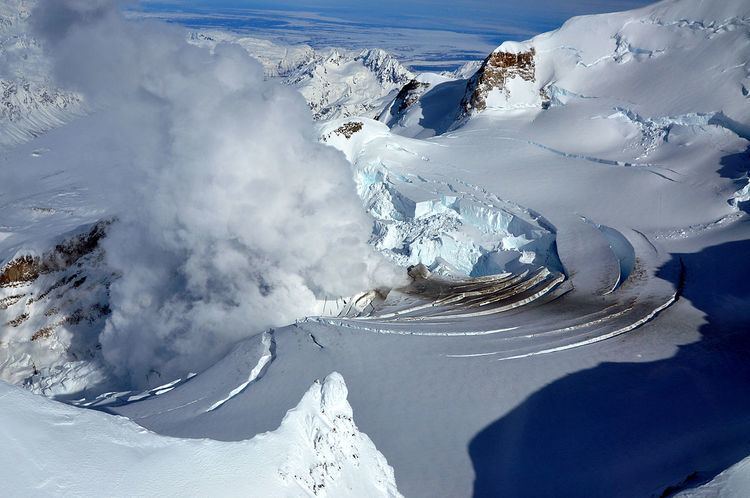 | ||
A fumarole (or fumerole - the word ultimately comes from the Latin fumus, "smoke") is an opening in a planet's crust, often in areas surrounding volcanoes, which emits steam and gases such as carbon dioxide, sulfur dioxide, hydrogen chloride, and hydrogen sulfide. The steam forms when superheated water vaporizes as its pressure drops when it emerges from the ground. The name solfatara, from the Italian solfo, "sulfur" (via the Sicilian language - compare to the volcano Solfatara), is given to fumaroles that emit sulfurous gases.
Fumaroles may occur along tiny cracks or long fissures, in chaotic clusters or fields, and on the surfaces of lava flows and of thick deposits of pyroclastic flows. A fumarole field is an area of thermal springs and gas vents where magma or hot igneous rocks at shallow depth release gases or interact with groundwater. From the perspective of groundwater, a fumarole could be described as a hot spring that boils off all its water before the water reaches the surface.
Fumaroles may persist for decades or centuries if located above a persistent heat source; or they may disappear within weeks to months if they occur atop a fresh volcanic deposit that quickly cools. The Valley of Ten Thousand Smokes, for example, was formed during the 1912 eruption of Novarupta in Alaska. Initially, thousands of fumaroles occurred in the cooling ash from the eruption, but over time most of them have become extinct.
An estimated four thousand fumaroles exist within the boundaries of Yellowstone National Park in the United States. In April 2006 fumarole emissions killed three ski-patrol workers east of Chair 3 at Mammoth Mountain Ski Area in California. The workers were overpowered by toxic fumes (a mazuku) that had accumulated in a crevasse they had fallen into. Another example is an array of fumaroles in the Valley of Desolation in Morne Trois Pitons National Park in Dominica.
Fumaroles emitting sulfurous vapors form surface deposits of sulfur-rich minerals; places in which these deposits have been mined include:
On Mars
The formation called Home Plate at Gusev Crater on Mars which was examined by the Mars Exploration Rover (MER) Spirit is suspected to be the eroded remains of an ancient and extinct fumarole.
